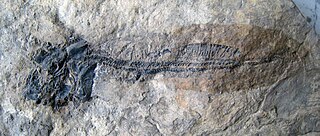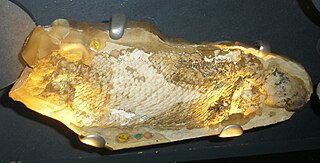
Anders Erik Vilhelm Jarvik was a Swedish paleontologist who worked extensively on the sarcopterygian fish Eusthenopteron. In a career that spanned some 60 years, Jarvik produced some of the most detailed anatomical work on this fish, making it arguably the best known fossil vertebrate.

Ctenurella is an extinct genus of ptyctodont placoderm from the Late Devonian of Germany. The first fossils were found in the Strunde valley in the Paffrather Kalkmulde.

Dipnorhynchus is an extinct genus of marine lungfish from the middle Devonian period (Emsian) of Australia.
Diabolepis is an extinct genus of very primitive marine lungfish which lived during in the Early Devonian period. It contains a single species, D. speratus of Yunnan, China, from the mid-late Lochkovian of the Xitun Formation. It is one of the oldest known lungfish genera. It is the only member of the family Diabolepididae and the order Diabolepidiformes, although neither of these parent taxa have been officially described, despite their names being in scientific usage.
The Xitun Formation is a palaeontological formation which is named after Xitun village in Qujing, a location in South China. This formation includes many remains of fossilized fish and plants of the Early Devonian period. It was originally referred to as the Xitun Member of the Cuifengshan Formation.
Ferganoceratodus is a genus of prehistoric lungfish known from the Mesozoic of Asia and Africa. Based on morphological evidence, it has either been recovered as a basal member of the Ceratodontiformes or to be the sister group of the Neoceratodontidae.

Chirodipterus is an extinct genus of marine lungfish which lived during the Devonian period. Fossils have been found worldwide, including Germany, China, eastern & western Australia, and the United States (Michigan). However, it has been suggested that the genus as currently defined is polyphyletic, in which case only the German type species would belong to the genus.
Uranolophidae is an extinct family of prehistoric lungfishes which lived during the Late Devonian period. Fossils have been found in North America.
Ichnomylax is an extinct genus of lungfish which lived during the Devonian period. Fossils have been found in Australia and Russia.
Ganopristodus is an extinct genus of prehistoric sarcopterygian or lobe-finned fish from the Devonian.
Iowadipterus is an extinct genus of prehistoric sarcopterygian or lobe-finned fish.
Mioceratodus is an extinct genus of lungfish in the family Neoceratodontidae, which also contains the extant Queensland lungfish. It is known only from Oligocene and Miocene-aged sediments in Australia, although phylogenetic evidence supports it having first diverged from its closest relative, Neoceratodus, during the Late Jurassic or Early Cretaceous period.
Rhinodipterus is an extinct genus of prehistoric dipnoan sarcopterygians or lobe-finned fish, that lived in the Devonian Period, between 416 and 359 million years ago. It is believed to have inhabited shallow, salt-water reefs, and is one of the earliest known examples of marine lungfish. Research based on an exceptionally well-preserved specimen from the Gogo Formation of Australia has shown that Rhinodipterus has cranial ribs attached to its braincase and was probably adapted for air-breathing to some degree as living lungfish are. This could be the only case known for a marine lungfish with air-breathing adaptations.

Ptychoceratodus is an extinct genus of lungfish living from Early Triassic to Middle Jurassic. It was established by Otto Jaekel for one species, transferred from Ceratodus genus. Type species is P. serratus from the Middle Triassic of Switzerland and Germany. Ptychoceratodus had two pairs of massive dental plates, bearing 4-6 acute ridges. Its skull roof was composed from massive, plate-like bones. In the central part of skull roof was localized an unossified fenestra. Most of the Ptychoceratodus findings are isolated dental plates, some associated with jaws. Other parts of skull or postcranial skeleton are relatively rarely found as fossils. The anatomy of skull is the best recognized in P. serratus, whereas less complete cranial material is available also for P. concinuus, P. phillipsi, and P. rectangulus. Although Ptychoceratodus is known exclusively from the Triassic and Jurassic, there were also Cretaceous specimens referred to this genus. However, they are more often regarded as representants of Metaceratodus. Ptychoceratodus is the only member of the family Ptychoceratodontidae. The first named species is P. phillipsi by Louis Agassiz in 1837 as a species of Ceratodus and later moved to Ptychoceratodus genus. Occurrences of Ptychoceratodus come mainly from Europe. However, occurrences from other continents suggest it was dispersed globally during the Triassic. After 2010, the new fossil material behind the Europe was reported from South America, India, and Greenland
Westollrhynchus is an extinct genus of prehistoric sarcopterygians or lobe-finned fish containing only one recognized species, Westrollrhynchus lehmanni.
Tarachomylax is an extinct genus of prehistoric sarcopterygians or lobe-finned fish.
Sorbitorhynchus is an extinct genus of prehistoric sarcopterygians, or lobe-finned fish. Fossils of this genus of marine lungfish have been found in Guangxi, China. The only described species in this genus is Sorbitorhynchus deleaskitus, but the holotype for this species may show some unusual malformations and thus not be useful for taxonomic or phylogenetic analysis.
Xeradipterus is an extinct genus of lungfish which existed in Australia during the Frasnian period. Of moderate size, it is believed to be a primitive member of the family Holodontidae characterized by its powerful crushing dentition with thick heels on the lower jaw tooth plates. The type and only specimen was found in the Gogo Formation by Lindsay Hatcher on an expedition to Gogo led by John A. Long on behalf of Museum Victoria in 2005.
Holodipterus gogoensis is an extinct species of lungfish from the late Devonian period of Europe and Australia.
The Wood Bay Series is a geologic formation found on the island of Spitsbergen, Svalbard in Norway. It preserves fossils dating back to the Pragian–Emsian stages of the Devonian period.






